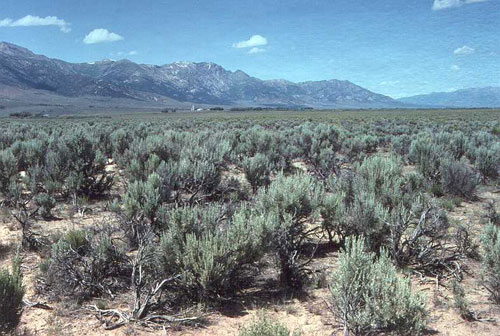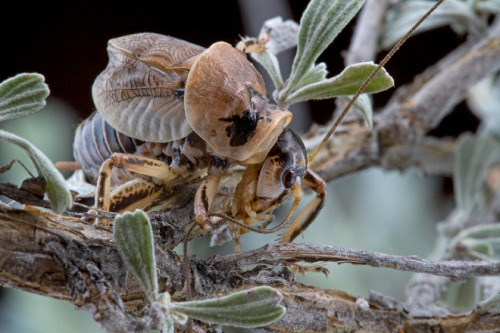(This video is about sage grouse conservation. It's mostly about Montana ecosystems though it gives some general information about sage grouse in the rest of the West. I only chose it because sage grouse are so reliant upon sagebrush--they use if for protection, nesting, and over 70% of their diet is sagebrush leaves. Sagebrush habitat is being cleared and fragmented by development, agriculture and industry. This causes genetic drift, inbreeding depression and isolation of sage-grouse populations reducing their genetic diversity and survivability as a species.)
You may've driven through some of the vast, lonely expanses of sagebrush communities in Utah, Nevada, Idaho, or elsewhere. Maybe you were bored. Maybe you were lost in thoughts and memories on the treadmill highway or maybe you had a Zen moment and just blended into the open spaces and the deep sky. Whatever your experience, did you ever eavesdrop on the sagebrush? Did you notice any unusual sounds? Like screaming for example?

True......if you look a sagebrush over you won't find a mouth. And they seem rather silent out there under the sky, subject to all of the elements, but the sagebrush do communicate amongst themselves in ways that they understand. They converse in the language of atoms and molecules. They make individually unique cocktails of compounds and these "words" are carried away by the wind. You might wonder what's being said and who's getting the message.
Sagebrush are actually part of a large genus with the scientific name Artemisia whose members can be found in temperate climates in both hemispheres of the world from Africa to the Americas. The Big Sagebrush (Artemisia tridentata) is one of the most common and important members of the semi-desert/steppe ecosystem that spans over 422,000 square miles of Western North America. Though it seems like a large area, sagebrush steppe is considered to be one of North America's threatened ecosystems and is sensitive to overgrazing and to non-native species invasions. Part of the reason for why it is considered an endangered ecosystem, despite the seemingly large area it inhabits, is that it is becoming a patchwork as we humans develop the land for our own purposes. Additionally, much of the sagebrush community now resides on private property and thus has little protection if the owners decide to clear it for their own purposes.
Artemisia tridentata can grow as tall as 15 feet and is well adapted to the demands of the semi-arid deserts of the American West. It has tap roots that can go over 15 feet deep to suck up any ground water that might exist and forms extensive webs of surface roots in association with symbiotic fungal hyphae to efficiently gather any rain that might fall. Oftentimes, sagebrush grows in clonal communities with members that can live over 100 years! (That's right, that sagebrush along the trail might be older than your grandpa.)
Sagebrush is an important member of an ecosystem that helps support many birds like the sage-grouse and sparrows, reptiles like lizards and tortoises, amphibians like desert toads, mammals like rabbits, mice and pronghorn amongst others, as well as an abundance of insects, worms, and microbes. One study done found nearly 300 arthropod species directly living on just a few sagebrush plants including 72 spider species and 237 insect species including 42 gall-forming insect species, 52 aphid species and 23 beetle species, amongst others like moths, butterflies and crickets. Such diversity is an indicator of a vibrant community despite the seemingly, barren backdrop of the desert. Such diversity also indicates that sagebrush and the species that call sagebrush home are playing an important part in maintaining the health of the environment providing ecosystem services such as soil protection, water conservation and nutrient cycling.

Big sagebrush get their characteristic smell from a mix of chemicals including camphor, terpenoids, and a cocktail of other volatile compounds. Some of the chemicals have anti-herbivory action by killing the gut bacteria of various browsers although pronghorn antelope seem to have evolved resistance to these toxins. Other browsers like cattle, sheep, and mule deer can only eat sagebrush in small doses or when the leaves are young and tender. Native Americans used sagebrush as an herbal medicine for various ailments and as incense.

It is the mixture of molecules that sagebrush make that come into play for communication. Sagebrush are eaten by many mammals and insects. When a sagebrush is browsed on by a pronghorn or a grasshopper, for example, volatile compounds are released from the wound that warn other branches of the same sagebrush as well as the neighboring sagebrush about the potential threat to them. The sagebrush in the area react to the warning by metabolizing toxins that make them taste unappealing and that cause digestive discomfort for future herbivores who try to make a meal of them.
The question could be asked, "Why not produce these toxins all of the time? Why take the risk on being damaged when you could be toxic and avoid any unwanted encounters all of the time?" The answer is at least two-fold. For one, metabolizing defense compounds requires energy and an organism only has so much energy that it can expend. If the risk of being eaten is low it is much more cost-effective to only create toxins when they're needed. Secondly, life evolves. If sagebrush became the only available food source and they were pumped full of toxins, they'd be putting a lot of selection pressure on the herbivores and only the toxin resistant members would survive to reproduce. Soon, only toxin resistant animals would exist and the sagebrush would have to evolve new toxins to survive. To slow the rate of evolution in their predators and to avoid the cost of an arms race, it's better that the sagebrush only apply defenses when it is necessary and take the risk on being browsed every now and then. There are probably many other reasons.
Not only do sagebrush send each other "Defend yourselves!" warnings, there is also evidence that other species of plants can interpret sagebrush language. Experiments done with tomato plants and wild tobacco plants show that when a sagebrush gets wounded and "screams" that the tomato and tobacco plants react by producing anti-herbivore compounds. It seems likely from this evidence that there are probably other plants living in the wild amongst sagebrush that receive and respond to the warnings too.
Scientists have chemically assayed the warning message and found that each sagebrush uses a slightly nuanced cocktail of compounds, indicating a certain individualized character of each message. Despite the fact that each individual sagebrush shouts their warning in a slightly different chemical dialect, the message is universally understood by other sagebrush in the community. No one yet knows how these slightly variable messages are consistently understood and the question could be asked whether the nuances in the message mean that more information is being communicated than just a simple warning.
Chemical communication between plants is a well established fact, but it isn't known what level of complexity can be expressed at the molecular level between plants. The fact that a dog can identify so many things based solely on smell, however, should give us pause. A dog can detect diseases, cancer, seizures, impending death, cadavers long decayed and buried deep in the ground, emotions, territories, quality of food, and identify individuals solely with their sense of smell, amongst many other things, which proves that the chemical world is full of information for those who can decipher it with their senses. There is even evidence that pigeons use chemical gradients and scent to find their way back home. Do plants possess the ability to decipher molecular messages with any sensitivity? Can they communicate more than warning screams? Science is still trying to find out.
On a more artistic plane, knowing that the sagebrush communicate in aromatic, molecular messages, why do some of us find the scent of sagebrush pleasant? It isn't food for us, but that piney-minty flavor was interpreted by Native Americans as an indicator of medicinal properties in the plant. Perhaps the aroma leaves an unconscious impression, like listening to a song that's in a language that you don't understand. You can't understand the literal meaning, but it still means something to the mind and body.

-Seth Commichaux
Sources cited:
Avian wildlife as sentinels of ecosystem health. Judit E.G. Smitsa, Kimberly J. Fernieb. 2012.
THE SPECIFICITY OF EAVESDROPPING ON SAGEBRUSH BY OTHER PLANTS. Richard Karban, Mikaela Huntzinger, and Andrew C. McCall. 2004.
SEASONAL PATTERNS OF ARTHROPOD DIVERSITY AND ABUNDANCE ON BIG SAGEBRUSH, ARTEMISIA TRIDENTATA. Sanford, Monte P. Huntly, Nancy J. 2010.
Clonal growth of sagebrush (Artemisia tridentata) (Asteraceae) and its relationship to volatile communication. Satomi Ishizaki, Kaori Shiojiri, Richard Karban, Masashi Ohara. 2012.
Savory Individuals. Anna Lena Phillips. American Scientist. Sep/Oct2009.
Greater Sage-Grouse and Natural Gas Development in Utah: Using Population Genetic Data For Conservation Efforts. Leah S. Breidinger, Karen E. Mock, and Terry A. Messmer. 2013.
http://en.wikipedia.org/wiki/Artemisia_tridentata
No comments:
Post a Comment